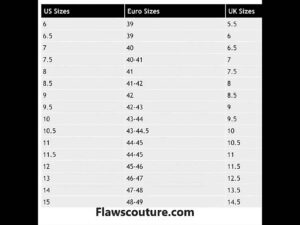When it comes to footwear, finding the perfect fit is paramount. In the UK, shoe sizes have historically been determined using the ‘barleycorn’ method.
A barleycorn, which equates to one-third of an inch, has traditionally represented the incremental measurement between full shoe sizes.
But how does UK size 8 measure up, and how does it compare to other international sizing systems? Let’s dive into the world of UK size 8 shoes.
Understanding UK Size 8
1. Measurement: A UK size 8 typically corresponds to a foot length of approximately 10.5 inches (26.7 cm).
2. Gender Differences: It’s crucial to note that UK shoe sizing doesn’t differentiate between men and women. So, a UK size 8 can be worn by anyone whose foot fits comfortably into the shoe, regardless of gender.
3. Width: While the length of a size 8 shoe in the UK is relatively standard, the width can vary. In the UK, shoe widths are often categorized from narrow (B) to extra wide (EEE), providing a range of options for various foot shapes.
International Comparisons
1. US Sizing: A UK size 8 for men typically converts to a US size 9. For women, it’s usually a US size 10 or 10.5.
2. European Sizing: In the European system, a UK size 8 translates to around a size 42.
3. Australian Sizing: For both men and women in Australia, a UK size 8 generally corresponds to an AU size 8.
Considerations for Buying
1. Brand Variations: Not every brand’s size 8 will feel the same. Always consult brand-specific sizing guides, read reviews, or try shoes on before purchasing.
2. Online Shopping: If you’re purchasing online, ensure there’s a comprehensive size guide available and a favorable return policy. Remember, the perfect size in one brand might differ in another.
3. Material Flexibility: Some materials, like leather, can stretch with wear, so it’s essential to factor in the potential for a slight increase in size over time.
4. Purpose of the Shoe: An athletic shoe in size 8 might feel different than a formal shoe of the same size. Consider the purpose and the expected comfort level when selecting the right fit.
In conclusion, a UK size 8 shoe offers a versatile fit for those with feet measuring around 10.5 inches in length.
However, always consider the specific requirements of your foot shape, the shoe’s purpose, and brand discrepancies before making a final decision.
Whether you’re walking the bustling streets of London or hiking in the Scottish Highlands, a well-fitted shoe is your ticket to comfort and style.
ALSO SEE: 45 Shoe Size in UK Sizing

FAQs on UK Shoe Size 8
- What is the foot length for UK size 8?
A UK size 8 typically corresponds to a foot length of approximately 10.5 inches (26.7 cm). - Is UK shoe sizing unisex?
Yes, UK shoe sizing doesn’t differentiate between men and women. - How does UK size 8 compare to US sizes?
For men, UK size 8 generally converts to US size 9, and for women, it’s usually US size 10 or 10.5. - What is the European equivalent for UK size 8?
A UK size 8 translates to around a European size 42. - Do all brands offer the same fit for size 8?
No, sizing can vary between brands. It’s always good to consult brand-specific sizing guides. - How do UK sizes differ from Australian sizes?
For both men and women in Australia, a UK size 8 typically corresponds to an AU size 8. - Are there width variations in UK size 8 shoes?
Yes, in the UK, shoe widths can range from narrow (B) to extra wide (EEE). - Does material affect the fit of size 8 shoes?
Certain materials like leather might stretch with time, affecting the fit. - Should I consider the shoe’s purpose when buying a size 8?
Absolutely. The fit and feel of an athletic shoe might differ from a formal shoe, even if both are size 8. - Is there a difference between UK size 8 for adults and children?
Yes, children’s shoe sizes follow a different scale. - How does UK shoe sizing historically determine sizes?
The ‘barleycorn’ method has traditionally been used, where one size difference equates to one-third of an inch. - What’s the best way to determine my UK shoe size?
Using a Brannock device or measuring your foot and referring to a sizing chart. - I wear a size 8 in UK; what size should I get for high heels?
Generally, it remains the same, but some women prefer a half size smaller in heels for a snug fit. - If I have wide feet, should I size up from 8 in the UK?
Not necessarily. You might want to consider a shoe with a wider width instead. - Is UK size 8 the same for all types of shoes?
No, there may be slight variations depending on the type of shoe (e.g., boots, sandals, athletic shoes). - How should a UK size 8 shoe fit?
Your toes shouldn’t touch the front, and there should be a snug fit without any discomfort. - Where can I find a comprehensive size guide for UK shoes?
Most online retailers or shoe stores will provide a size guide. - Are half sizes available between UK size 8 and 9?
Yes, many brands offer half sizes. - How do UK shoe sizes convert to Asian sizes?
Conversion can vary, but a UK size 8 is typically around a 26 or 27 in Asian sizes. - Can I find wide or narrow variants in UK size 8?
Yes, many brands offer width variants. - Is UK size 8 common?
Yes, it’s a fairly common size in the UK. - Can shoe insoles affect the fit of a UK size 8?
Yes, thick insoles might make the shoe feel tighter. - How does UK sizing compare to Italian sizing?
Italian sizing is typically two sizes higher. So UK 8 might be Italian 40. - What type of socks should I wear when trying on a size 8 shoe?
Wear the kind of socks you plan to wear with the shoe for the best fit. - How has UK shoe sizing evolved over time?
While the barleycorn method remains foundational, many modern brands now use advanced technology to ensure better fits. - Are UK size charts the same worldwide?
No, always refer to the specific chart provided by the retailer or brand. - How does shoe width affect size selection in the UK?
A wider foot might require a wider width rather than a larger shoe size. - Is there a specific time of day best for trying on shoes?
Afternoons or evenings, as feet can swell during the day. - How often should I measure my foot size?
Adults can measure every couple of years. Children and teenagers should measure more frequently due to growth. - What if I’m between sizes?
Consider half sizes or insoles. - Can medical conditions affect shoe size?
Yes, conditions like edema can cause feet to swell. - Do vegan or sustainable shoes come in UK size 8?
Yes, many sustainable brands offer a range of sizes, including size 8. - Are there specific shoe types that don’t come in standard sizes like 8?
Most standard shoe types come in size 8, but artisanal or custom shoes might differ. - How do I care for my UK size 8 shoes to maintain their fit?
Store them properly, keep them clean, and avoid excessive wet conditions. - Is there a return policy if my UK size 8 shoe doesn’t fit well?
Most retailers offer return policies, but always check the terms before purchasing. - Can foot exercises change my shoe size?
Not significantly, but foot health can affect comfort and fit. - Why do some brands not offer half sizes after UK size 8?
Branding decisions vary, but demand and manufacturing costs can be factors. - How does aging affect foot size?
Feet can flatten and widen slightly with age. - Is UK size 8 available in all shoe styles?
While most mainstream styles offer size 8, some niche or bespoke styles may have limited size ranges. - Can weight changes affect my shoe size?
Significant weight gain or loss can impact foot size and shape.
I hope this provides clarity on the topic of UK shoe size 8. Always ensure the comfort and fit of any shoe before purchase.

Leave a Reply